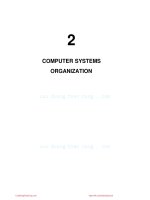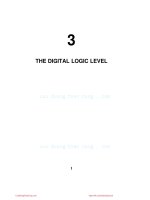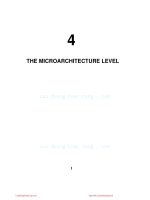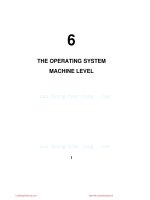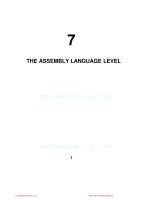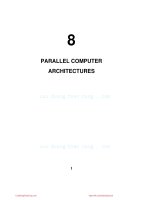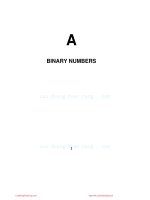kiến trúc máy tính dạng thanh tin figs b floating point numbers sinhvienzone com
Bạn đang xem bản rút gọn của tài liệu. Xem và tải ngay bản đầy đủ của tài liệu tại đây (24.28 KB, 7 trang )
B
FLOATING-POINT NUMBERS
1
CuuDuongThanCong.com
/>
5
Positive
underflow
3
Negative
underflow
1
Negative
overflow
—10100
2
Expressible
negative numbers
4
Zero
—10—100 0
6
Expressible
positive numbers
10—100
7
Positive
overflow
10100
Figure B-1. The real number line can be divided into seven regions.
CuuDuongThanCong.com
/>
Digits in fraction Digits in exponent Lower bound Upper bound
3
1
10−12
109
3
2
10−102
1099
3
3
10−1002
10999
3
4
10−10002
109999
4
1
10−13
109
4
2
10−103
1099
4
3
10−1003
10999
4
4
10−10003
109999
5
1
10−14
109
5
2
10−104
1099
5
3
10−1004
10999
5
4
10−10004
109999
10
3
10−1009
10999
20
3
10−1019
10999
Figure B-2. The approximate lower and upper bounds of expressible (unnormalized) floating-point decimal numbers.
CuuDuongThanCong.com
/>
Example 1: Exponentiation to the base 2
2–2
2
Unnormalized:
0 1010100
–1
.0
2–4
2
–3
2–6
2
–5
2–8
2
–7
2–10
2
–9
2
2–12
–11
2
2–14
–13
2
2–16
–15
20
–12
–13
–15
0 0 0 0 0 0 0 0 0 0 1 1 0 1 1 = 2 (1 × 2 + 1 × 2 + 1 × 2
+ 1 × 2–16) = 432
Sign Excess 64
Fraction is 1 × 2–12+ 1 × 2–13
–15
–16
+ exponent is
+1 × 2 + 1 × 2
84 – 64 = 20
To normalize, shift the fraction left 11 bits and subtract 11 from the exponent.
Normalized:
0 1001001
.1
1 0 1 1 0 0 0 0 0 0 0 0 0 0 0 = 29 (1 × 2–1+ 1 × 2–2+ 1 × 2–4
+ 1 × 2–5) = 432
Fraction is 1 × 2–1 + 1 × 2–2
+1 × 2–4 + 1 × 2–5
Sign Excess 64
+ exponent is
73 – 64 = 9
Example 2: Exponentiation to the base 16
Unnormalized:
0 1000101
.
16–1
16–2
16–3
0 0 00
0 0 00
0 0 01
16–4
1 0 1 1 = 165 (1 × 16–3+ B × 16–4) = 432
Fraction is 1 × 16–3 + B × 16–4
Sign Excess 64
+ exponent is
69 – 64 = 5
To normalize, shift the fraction left 2 hexadecimal digits, and subtract 2 from the exponent.
Normalized:
0 1000011
Sign Excess 64
+ exponent is
67 – 64 = 3
.
0001
1011
0000
0 0 0 0 = 163 (1 × 16–1+ B × 16–2) = 432
Fraction is 1 × 16–1 + B × 16–2
Figure B-3. Examples of normalized floating-point numbers.
CuuDuongThanCong.com
/>
Bits 1
8
23
Fraction
Sign
Exponent
(a)
Bits 1
11
52
Exponent
Fraction
Sign
(b)
Figure B-4. IEEE floating-point formats. (a) Single precision. (b) Double precision.
CuuDuongThanCong.com
/>
Item
Single precision
Double precision
Bits in sign
1
1
Bits in exponent
8
11
Bits in fraction
23
52
Bits, total
32
64
Excess 127
Excess 1023
−126 to +127
−1022 to +1023
Smallest normalized number
2−126
2−1022
Largest normalized number
approx. 2128
approx. 21024
Exponent system
Exponent range
Decimal range
Smallest denormalized number
approx. 10−38 to 1038 approx. 10−308 to 10308
approx. 10−45
approx. 10−324
Figure B-5. Characteristics of IEEE floating-point numbers.
CuuDuongThanCong.com
/>
Normalized ±
0 < Exp < Max
Any bit pattern
Denormalized ±
0
Any nonzero bit pattern
Zero ±
0
0
Infinity ±
1 1 1…1
0
Not a number ±
1 1 1…1
Any nonzero bit pattern
Sign bit
Figure B-6. IEEE numerical types.
CuuDuongThanCong.com
/>

